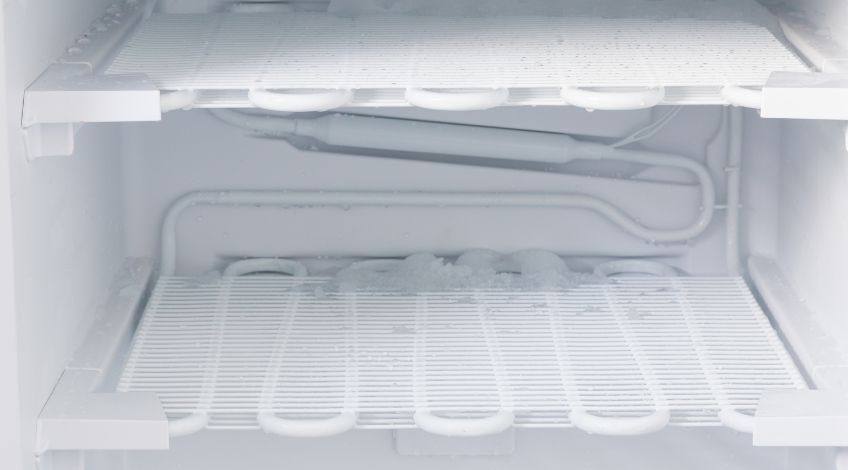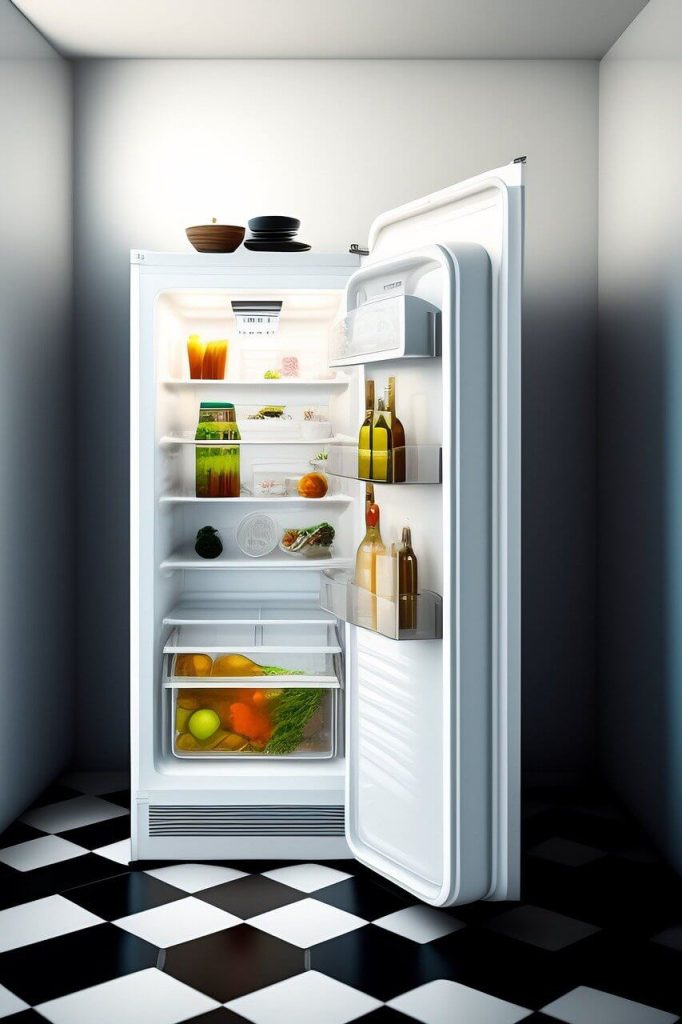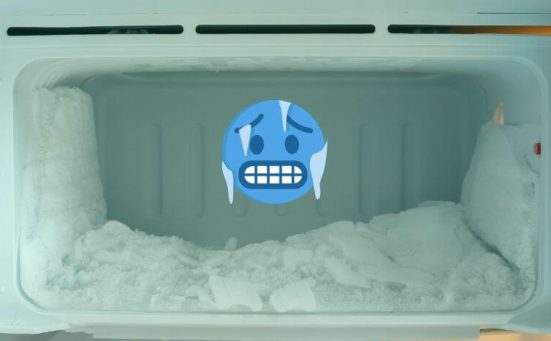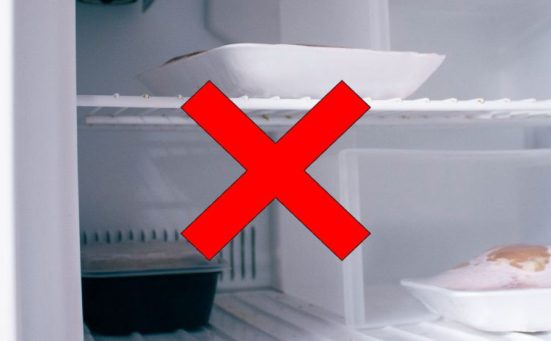
Samsung Refrigerator Defrost Problem? (here’s why & what to do)
If you are having problems with defrosting your Samsung refrigerator it could be caused by a number of things. There could be warm air entering the fridge through the door, a lack of ventilation, a faulty ice flap, problems with the drain tube, a refrigerant leak or a component failure.
In this article we’ll take a close look at each of these possibilities and offer solutions for them.
How To Initiate The Defrost Mode On A Samsung Refrigerator
Before we look at all of the possible reasons why your Samsung refrigerator might be having problems defrosting, we need to mention the defrost mode which is installed into every Samsung refrigerator.
Samsung refrigerators automatically defrost several times every day for around 20 minutes per time. So any problems with defrosting indicate that the defrost mode isn’t functioning.
If the defrost mode isn’t working at all or isn’t functioning as it should, you will need to manually defrost the fridge. This can be done by employing the following steps;
- Enter Diagnostic Mode
Press and hold the light + freezer or power freeze + fridge buttons for 10 seconds or until you hear the beep. That beep indicates that the fridge has entered diagnostic mode. - Select A Defrost Mode
Once in diagnostic mode you have the choice between 2 different defrost settings which are;- Refrigeration Defrost (RD)
The RD mode defrosts only the fresh food section or refrigerator compartment. If there is only ice built up in the fridge section that you want to defrost, select this option. - Full Defrost (FD)
The FD mode defrosts the whole appliance-the fridge and the freezer. Select this option if you want to fully defrost the whole appliance.
- Refrigeration Defrost (RD)
- Allow The Defrost To Finish
After you have selected the option that suits your needs, you will need to allow sufficient time for the defrost to complete. This can be anywhere between 20 to 60 minutes and is dependent on just how much ice build up there is. Once the defrost has completed, the appliance will beep to let you know.
Other Methods Of Defrosting A Samsung Refrigerator

There are other ways to defrost your Samsung refrigerator without using the defrost mode which include;
Leaving The Fridge Door Open
Leaving the fridge door open when it’s running can increase ice build up. However, once the power has been disconnected, you should leave the door open to allow warm air to enter the fridge to help melt any ice that has built up inside.
Using Bowls Of Hot Water
You can help speed up the time needed to melt any ice build ups by placing bowls of hot water inside the fridge on the shelves. Ensure that you have disconnected the power supply first and then fill a few bowls with hot water and leave them on the shelves of the fridge.
You will need to replace the hot water as soon as it cools down to expedite the melting process.
Using A Portable Fan
With the fridge door open, you can direct warm air from the kitchen into the fridge to help melt any ice build up.
Using A Hairdryer
Using a hairdryer to help melt ice in the fridge can be dangerous so you will need to exercise extreme caution. However, the warm air from the hairdryer can really speed up the thawing process.
You should keep the nozzle moving constantly to prevent damaging the plastic interior of the fridge. Position the nozzle at least 5-6 inches away from the walls or surfaces of the fridge.
Using A Hand Steamer
If you own a hand steamer, it is a much safer option compared to a hairdryer. Just ensure the fridge is completely empty before directing steam at the ice.
Why Is My Samsung Refrigerator Having Defrost Problems?
There are several reasons why your Samsung refrigerator might be having defrost problems which include;
| Probable Cause | Solution |
|---|---|
| Fridge Door Open | Force defrost the refrigerator and ensure the door is fully closed |
| Faulty Door Seal | Inspect, clean or replace the door seal as necessary |
| Overfull Fridge/Freezer | Ensure there is adequate space between items to allow sufficient air flow |
| Ice maker Flap Stuck Open | Clear any obstructions that could be preventing the ice maker flap from closing properly |
| Drain Tube Issues | Get the drain tube inspected by a technician |
| Defective Defrost Timer | Get a technician to investigate and replace if necessary |
| Defective Defrost Heater | Get a technician to investigate and replace if necessary |
| Defective Defrost Thermostat | Check the defrost thermostat and replace if necessary |
| Defective Defrost Control Board | Check the defrost control board and replace if necessary |
| Defective Defrost Sensor Fuse | Check the defrost sensor fuse and replace it if necessary |
| Faulty Compressor | Contact a technician |
| Control Board Malfunction | Contact a technician |
| Refrigerant Leak | Contact a technician |
Let’s look at each of these issues in more depth;
Fridge Door Open

If you leave the fridge door open for extended periods or fail to close it properly, warm air from the kitchen will get into the fridge. This hot air will cause ice to build up at a fast rate.
The excessive ice build up caused by hot air, will often be too much for the auto defrost to deal with. To prevent this from happening always ensure you close the fridge door properly as soon as you have got whatever you need from the fridge.
If the ice has built up to such an extent that the automatic defrost can’t cope with it, you will need to use one of the defrost methods above to clear it.
Faulty Door Seal
There is a rubber seal fitted all around the door of your refrigerator. It is designed to keep warm air out of the fridge. Over time food particles, dirt and debris can build up on the door seal which can prevent the door from closing properly.
You should inspect the door seal and remove any dirt or debris using a damp cloth. If the door seal is damaged, it will need to be replaced.
Overfull Fridge/Freezer
For your fridge to defrost correctly, it needs an adequate air flow. If you cram too much into the fridge and freezer, it can prevent enough air flow for the defrost function to work.
It is also possible that the air vents have been blocked by items packed too closely together in the appliance which can also impede the defrost function.
You will need to reduce the amount of items crammed into the fridge and freezer and ensure that nothing is touching the fridge or freezer walls. You should also check to make sure that nothing is blocking the vents.
Ice Maker Flap Stuck Open
Over time, dirt and debris can clog the ice maker flap and prevent it from closing. The added cold air from the ice maker can prevent the auto defrost function from melting all of the ice.
To solve this you will need to inspect the ice maker flap and remove any dirt, debris or ice that has accumulated. Make inspecting the ice maker flap a regular part of your cleaning routine to prevent this from happening again.
Drain Tube Issues
The drain tube can become clogged with dust or develop a leak. Either of these issues can cause the auto defrost to fail.
The first thing you should do is try a forced defrost on your appliance. If this fails to clear the problem, we recommend contacting a technician who will have the skills to solve this issue.
Defective Defrost Timer

The defrost timer turns on the defrost heater at a set time to melt any accumulated ice on the evaporator coils. If the defrost timer fails or develops a fault, the heater won’t start and the ice will keep building up.
We recommend contacting a technician to investigate this further.
Defective Defrost Heater
The defrost heater should operate every 30 minutes or so. If it fails to work, or becomes defective, the fridge will not defrost.
If you suspect this is the cause of the problem, we recommend contacting a technician to investigate and replace the defrost heater if necessary.
Defective Defrost Thermostat
If the defrost thermostat is defective it won’t send the correct message to the control board and the defrost won’t start.
Consult your user manual on the location of the defrost thermostat and check it for continuity using a multimeter. If it proves to be faulty, it will need to be replaced.
Defective Defrost Control Board
The defrost control board controls the frequency of the automatic defrost cycle. If it develops a fault or becomes defective, the fridge will not enter the defrost mode.
If the defrost heater and defrost thermostat are both working properly and the auto defrost doesn’t initiate, it’s often due to a defective defrost control board.
We recommend getting a technician to investigate and replace the defrost control board if necessary.
Defective Defrost Sensor Fuse
The defrost sensor has a fuse that protects it from damage due to overheating. If the fuse blows, the sensor cannot monitor the temperature of the evaporator.
This can lead to the fridge becoming iced up and the defrost function will not operate. You can check the sensor fuse for continuity using the multimeter and replace it if it proves to be faulty.
Faulty Compressor

If the compressor develops a fault it can prevent the fridge from defrosting. The compressor is a difficult part to access and is best left to a technician to check.
The technician will also be able to advise you whether it’s financially viable to replace the compressor or replace the refrigerator.
Control Board Malfunction
The control board manages every function on your Samsung refrigerator. If it becomes defective, the appliance will not cool or freeze nor will the defrost function operate.
The control board is a delicate and expensive component. Which is why we recommend contacting a technician to investigate it for you. As control boards are so expensive, you may be better off to replace the refrigerator than to buy a replacement part.
Refrigerant Leak
If you’ve had everything else checked, the only other thing that could cause the refrigerator to fail to defrost is a refrigerant leak. If the refrigerant level is low in the compressor, it will not function properly.
It will release warm gas instead of cold gas. This is another part best left to a technician to check because a refrigerant leak can be difficult to fix.
What Does The 5E Error Code Mean On A Samsung Refrigerator?
If your Samsung refrigerator is displaying the 5E error code it indicates a fault connected to the defrost system. It can also be caused by a glitch which can often be cleared in one of two ways;
- Reset The Refrigerator by disconnecting the power supply for 10 to 15 minutes.
- Press & Hold The PowerFreeze + PowerCool buttons for 10 seconds
SEE ALSO: Samsung Refrigerator Freezing Food? (do this asap)
Frequently Asked Questions
If you are moving home and you need to safely move your Samsung refrigerator you should manually force a defrost by entering Diagnostic Mode by holding the light + freezer buttons for 10 seconds until the beep. Select Refrigeration Defrost (RD) or Full Defrost (FD), then wait for the defrost cycle to complete and beep. This allows you to defrost the fridge and freezer before shutting it down prior to your move.
If your Samsung fridge isn’t defrosting it could be because; the fridge door isn’t closed properly, the fridge and freezer are too full, the vents are blocked, the ice maker flap is stuck open, there is a problem with the drain tube or there is a defective component.
Your Samsung fridge freezer may keep icing up because; the door isn’t closed properly and warm air is entering, the door seals are faulty, poor ventilation, overcrowding the fridge and freezer, the ice maker flap is stuck in the open position, there is a problem with the drain tube or one of the components is defective.
If your Samsung French door refrigerator keeps icing up it could be because; warm air is entering through the open door, the door seals are faulty and need replacing, the compartments are overfull leading to insufficient air flow, the drain tube is leaking or clogged, there is a refrigerant leak or one of the components has developed a fault.
Also, follow us on Pinterest ...



